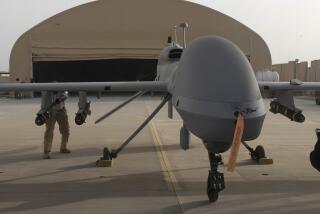Suspected Zarqawi Heir Given a Face
- Share via
BAGHDAD — The U.S. military released new information Thursday about the Egyptian militant it believes has taken the place of Abu Musab Zarqawi as the head of Al Qaeda in Iraq.
At a news briefing in the Iraqi capital, the U.S. military showed reporters a previously classified picture of the Egyptian-born bomb expert known as Abu Ayyub Masri or, more recently, Sheik Abu Hamza, also called “Al Muhajir.”
“It’s important for the people of Iraq to know who this is,” said Army Maj. Gen. William B. Caldwell IV, spokesman for U.S.-led forces in Iraq.
Caldwell said U.S. officials for days debated whether releasing the photo and a brief biographical sketch would bolster the Egyptian’s media profile, and play into his hands. “Our intention is not to glorify him,” he said.
The U.S. intention instead appears to be to keep attention on the foreign element of Iraq’s insurgency -- a small but effective force within a broader opposition led by Sunni Arabs. Masri and Muhajir mean “Egyptian” and “immigrant,” respectively, in Arabic.
“He has absolutely no ties to this country,” Caldwell said.
In Washington, Stephen Hadley, President Bush’s national security advisor, said questions remained as to whether Masri was indeed stepping into Zarqawi’s position.
“We’re not actually certain that he is the person who’s going to step forward to lead this organization. There’s still some uncertainty on that,” Hadley told reporters. “That’s clearly one of the leading names. But we’re going to need a little bit of time to sort [it] out.”
Masri began his journey in Islamist circles in 1982 as a disciple of Ayman Zawahiri, the Egyptian physician who now is a deputy to Osama bin Laden, said Caldwell, citing information from the Defense Intelligence Agency.
He went to Taliban-ruled Afghanistan in 1999, where he trained at Bin Laden’s Farouk camp and met Zarqawi. After the 2001 U.S.-led invasion of Afghanistan, he made his way to Iraq, where he united with Zarqawi and became his trusted deputy.
During the first year of the Iraq insurgency, Masri helped draw other insurgent groups into Al Qaeda in Iraq’s fold and worked with Zarqawi’s deputies in Fallouja, deploying suicide and car bombers to other parts of the country, the military said.
After U.S. Marines overran Fallouja in November 2004, Masri became Al Qaeda in Iraq’s emir, or leader, of southern Iraq.
U.S. military officials Thursday also provided details of the June 7 bombing of Zarqawi’s hide-out near Baqubah. According to a timeline provided by the military, two men in a vehicle -- possibly informants deep inside Zarqawi’s network -- left the house just minutes before U.S. forces verified that there were no friendly forces in the area and ordered the airstrike.
Caldwell said Zarqawi, who lived for nearly an hour after the bombing, spit up a pint and a half of blood while being treated, a sign that he had suffered massive internal trauma as a result of two 500-pound bombs dropped by an F-16 fighter jet.
Caldwell said the bombing badly damaged Zarqawi’s network, throwing its leadership into disarray and forcing the abandonment of trusted hide-outs. In the week since Zarqawi’s death, U.S. and Iraqi forces have conducted 452 raids and killed 104 insurgents, he said.
But Caldwell added that Zarqawi’s organization was expected to “reset” under new leadership. “They’ve been very resilient,” he said.
Iraqi national security advisor Mowaffak Rubaie, a Shiite, released a purported Al Qaeda in Iraq memo that said insurgents were having trouble holding their own against U.S.-trained Iraqi forces and aimed to spark a war between Iran and the United States as a way to distract Americans.
“We think that the best suggestions in order to get out of this crisis is to entangle the American forces into another war against another country ... and inflame the situation between America and Iran,” said a translation of the document released by Rubaie. Caldwell told reporters that the document, discovered at a Zarqawi hide-out before last week’s bombing, appeared authentic.
But its rhetoric and tactics differed markedly from previous Al Qaeda in Iraq documents or public communications and appeared to reflect allegations against the insurgency made by Shiite government officials.
Even as U.S. officials highlighted their efforts to fight off the insurgency, Iraqi authorities have revived overtures toward the fighters. Those moves, however, appeared to come to an abrupt and unexplained halt Thursday.
Prime Minister Nouri Maliki, who on Wednesday mentioned a proposal to talk with insurgents, invited reporters Thursday to his office in the U.S.-controlled Green Zone, where they were handed a two-page communique titled “National Reconciliation.” But Maliki failed to show, and aides soon collected the documents, canceling the news conference without explanation.
Calm prevailed Thursday throughout much of Baghdad, which is under a new security plan and a 9 p.m. curfew, but at least 18 Iraqis were killed elsewhere, and seven bodies were discovered.
Interior Ministry officials said 10 tribal relatives of Sunni Arab lawmaker Mohammed Daeni were pulled off a bus and shot dead near Baqubah. Daeni had videotaped prisoners alleging torture and corruption in a local jail and sent the footage to Arab television stations.
Gunmen also killed four civilians and injured 14 near a mosque in Tikrit. A city official was assassinated in Basra. A roadside bomb killed three civilians near Hillah. Police also found seven unidentified bodies, bearing bullet wounds and signs of torture, in various parts of the capital.
Special correspondents in Baqubah and Tikrit and Times staff writer James Gerstenzang in Washington contributed to this report.
More to Read
Sign up for Essential California
The most important California stories and recommendations in your inbox every morning.
You may occasionally receive promotional content from the Los Angeles Times.










